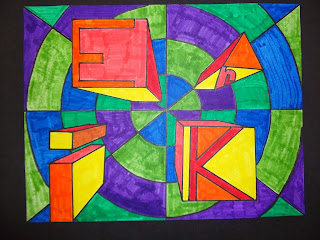Dear Students and Parents,
This year in 6th
grade, every student takes art class. I
am very excited and honored to have the opportunity to lead students though the
6th grade art curriculum. I
have a few things I would like to share with you about what our year in art
will look like.
1.
Goals: (A
few of my goals for the year).
a.
Create a fun and
positive learning environment for each student.
b.
Challenge each
student to think, problem-solve, be creative, and grow.
c.
Share my love and
passion for art (hopefully it becomes contagious).
d.
Enhance each
student’s artistic vocabulary/understanding of the art elements and principles.
e.
Clearly
communicate weekly through family access and share pictures on the 6th
grade art blog.
2.
Expectations: (A few things I appreciate from students in the art room).
a.
Come to art class
prepared with a pencil each session.
b.
Come with a
positive attitude and willingness to work.
c.
Come ready to
give your best and use art time to its fullest!
Stay on task!
3.
Pacing:
a.
Each class comes to
art once a week, which is 35 times this year.
Once you factor in snow days, days off, assemblies, band/choir concerts
etc… we will have less than that original 35.
b.
Please be patient
(everyone). Many of our projects take
four or more sessions to complete, so as we only meet once a week, that
translates to a month or longer for most of our projects.
c.
There may be long
stretches of time where student artwork will be at school. All artwork will be sent home by the end of
the year.
d.
Overall, we move
slowly but produce high quality work!
4.
Classroom Behavior: (With time at such a premium, I have high
expectations for student behavior).
a.
Positive
attitude, positive participation, and positive comments.
b.
Use work time in
a productive manner, try your best, and do not give up!
c.
Respect each
other and the classroom/materials.
5.
Grades:
(I use the traditional 4.0 letter grade system).
a.
I grade based on
two things: The artwork and participation/effort.
b.
Each time a
student is in class, they earn or lose up to five points. At the end of the marking period, points are
tallied and count as a participation/effort grade (equivalent to a project).
c.
I grade the
artwork based on several factors:
i.
The main learning
objectives of the project.
ii.
Craftsmanship,
this is how neat and orderly the artwork is.
iii.
Use of class
time, I analyze if students are “on task” and how well they use work time.
iv.
Effort/attitude
(listening, following directions, helping during clean up, etc…)
6.
Homework:
(There is usually no homework).
a.
There may be a
writing assignment or two sent home as homework, an information sheet will
accompany any such assignments.
7.
Make-up Work: (If you are a slow artist or miss an art session, there are many ways
to catch up).
a.
All assignments
in each marking period must be completed before grades are due, that is usually
one week before the end of the marking period.
i.
Connect time. Just get a pass from Mr. VandenBerg and come
work.
1.
East = Tuesdays
2.
North = Thursdays
ii.
Before or after
school. I make myself available before
or after school on Monday thru Thursday.
Parents, please officially schedule ahead of time through e-mail or
phone to ensure I do not have a scheduling conflict of some kind.
1.
East = Mondays
and Tuesdays
2.
North =
Wednesdays and Thursdays
iii.
Lunch time. Students please schedule ahead of time so I
know you are coming.
1.
East = Mondays
and Tuesdays
2.
North =
Wednesdays and Thursdays
8.
Discipline:
a.
The art room
should be a safe, quiet environment where students feel free to focus, be
creative, and explore/experiment with the learning objectives.
b.
We will build a
social contract early in the year which we will need to abide by.
c.
I want the best
for each student, I want each student to have fun and enjoy art time, but there
are circumstances that require a discipline framework.
d.
I like to use the
old baseball “Three Strikes & You’re Out”
i.
Strike 1 =
“four questions” and a verbal reminder.
ii.
Strike 2 =
“four questions”, verbal warning, and possible demerit or lunch detention.
iii.
Strike 3 =
Behavior discussion, “four questions”, lunch or after school detention, parent
phone call, possible trip to the office.
e.
Three demerits in
a semester will equal a detention.
f.
Three times being
tardy to class in a semester will equal a detention.
9.
Project Outlook: (A quick look at our units).
·
One point
perspective drawing
·
Color: abstract
color wheel and color scheme painting
·
Pottery: Native
American Indian pinch pots
·
Printmaking:
Designing a cover for an autobiography
·
Cubism: Art
history and an abstract self-portrait
·
Realistic
observational drawing
Thank you for taking the time to get to
know the 6th grade art program a little better. I look forward to having a great year with
the 6th grade students.
Sincerely,
Mr. VandenBerg
6th Grade Art Teacher

































































